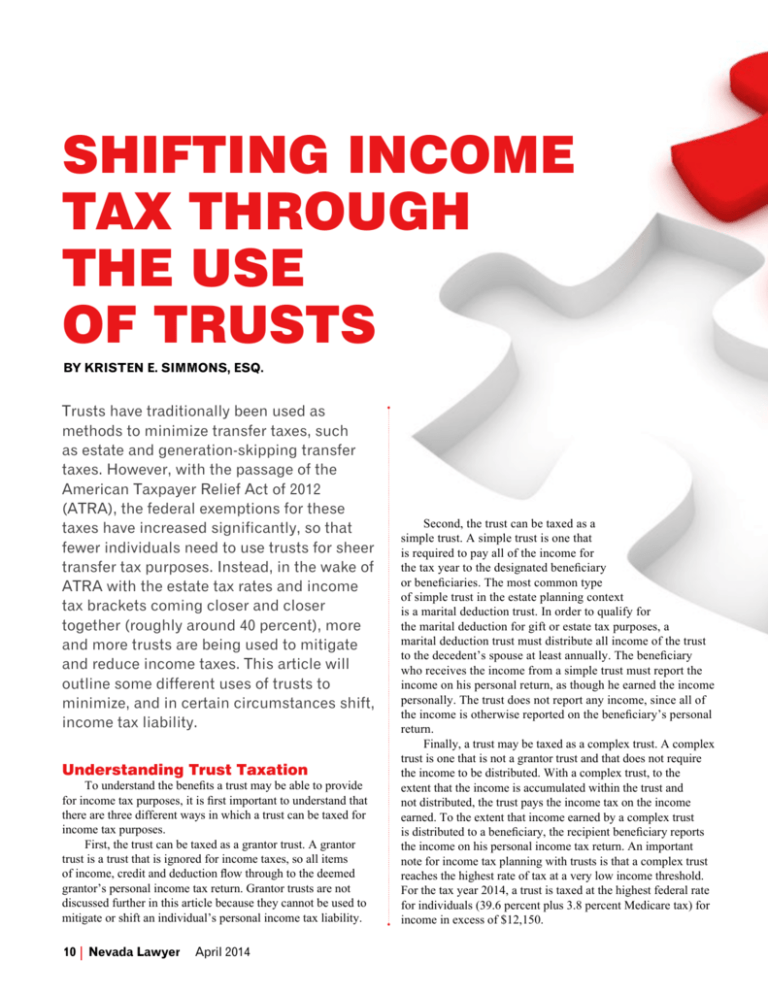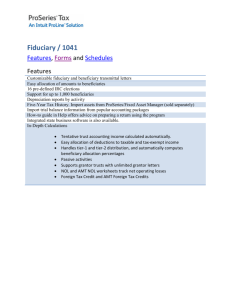shifting income tax through the use of trusts
advertisement

SHIFTING INCOME TAX THROUGH THE USE OF TRUSTS BY KRISTEN E. SIMMONS, ESQ. Trusts have traditionally been used as methods to minimize transfer taxes, such as estate and generation-skipping transfer taxes. However, with the passage of the American Taxpayer Relief Act of 2012 (ATRA), the federal exemptions for these taxes have increased significantly, so that fewer individuals need to use trusts for sheer transfer tax purposes. Instead, in the wake of ATRA with the estate tax rates and income tax brackets coming closer and closer together (roughly around 40 percent), more and more trusts are being used to mitigate and reduce income taxes. This article will outline some different uses of trusts to minimize, and in certain circumstances shift, income tax liability. Understanding Trust Taxation To understand the benefits a trust may be able to provide for income tax purposes, it is first important to understand that there are three different ways in which a trust can be taxed for income tax purposes. First, the trust can be taxed as a grantor trust. A grantor trust is a trust that is ignored for income taxes, so all items of income, credit and deduction flow through to the deemed grantor’s personal income tax return. Grantor trusts are not discussed further in this article because they cannot be used to mitigate or shift an individual’s personal income tax liability. 10 Nevada Lawyer April 2014 Second, the trust can be taxed as a simple trust. A simple trust is one that is required to pay all of the income for the tax year to the designated beneficiary or beneficiaries. The most common type of simple trust in the estate planning context is a marital deduction trust. In order to qualify for the marital deduction for gift or estate tax purposes, a marital deduction trust must distribute all income of the trust to the decedent’s spouse at least annually. The beneficiary who receives the income from a simple trust must report the income on his personal return, as though he earned the income personally. The trust does not report any income, since all of the income is otherwise reported on the beneficiary’s personal return. Finally, a trust may be taxed as a complex trust. A complex trust is one that is not a grantor trust and that does not require the income to be distributed. With a complex trust, to the extent that the income is accumulated within the trust and not distributed, the trust pays the income tax on the income earned. To the extent that income earned by a complex trust is distributed to a beneficiary, the recipient beneficiary reports the income on his personal income tax return. An important note for income tax planning with trusts is that a complex trust reaches the highest rate of tax at a very low income threshold. For the tax year 2014, a trust is taxed at the highest federal rate for individuals (39.6 percent plus 3.8 percent Medicare tax) for income in excess of $12,150. State Income Tax Savings Shifting Income to Beneficiaries in Lower Brackets If a client has beneficiaries in another state that has a state income tax, a trust can be used to save state income taxes for the otherwise-taxed beneficiary or beneficiaries. For example, if a Nevada resident has children who live in California, the Nevada resident could leave the inheritance for the child who lives in California in a continuing complex trust. To the extent that the child in California does not need the income from the inheritance (but is rather saving it for the future), the income would accumulate within the complex trust and be protected from California state income tax. In order to be protected from California state income tax, (i) the income earned by the trust cannot be California source income and (ii) the fiduciaries (trustees) of the complex trust would have to be non-residents of California. In this example, it would be natural for the Nevada resident to name another Nevada resident or a Nevada bank or trust company as the fiduciary of the complex trust for the California-resident beneficiary. In addition to protecting a beneficiary’s inheritance from potential state income tax, many clients from neighboring states like California have been seeking Nevada counsel to help them reduce their lifetime state income tax liabilities. A trust that is often referred to as a NING (standing for Nevada continued on page 13 One planning opportunity is for a senior generation to transfer an income-producing asset to a trust that is either a simple trust or complex trust for income tax purposes. As income is earned by the trust, if it is distributed to a beneficiary who is in a lower income tax bracket than the senior generation, there is an overall family savings of income tax associated with the asset. This method of overall family income tax savings would be attractive to a client who is already making transfers to lower-generation family members. For example, if a client is using the income from a specific asset to pay for education or medical expenses for a family member, the client would transfer the asset to a trust that includes that family member (or members) as a beneficiary. If the trust is structured as a complex trust, the trustees would have more flexibility to determine whether a certain beneficiary is in a lower income tax bracket than the trust. As income is earned by the trust, the income could be distributed to a beneficiary in the lower tax bracket and then, in turn, be used by the beneficiary to pay the medical or educational expenses that the senior generation would have paid anyway. The trust can be structured such that the transfer of the asset to the trust is either a completed gift or an incomplete gift for transfer tax purposes. Advisors may want to consider using an incomplete gift version of this type of trust in order to achieve a step up in basis in the transferred asset at the death of the senior generation. April 2014 Nevada Lawyer 11 SHIFTING INCOME TAX THROUGH THE USE OF TRUSTS continued from page 11 Incomplete gift Non-Grantor trust), may be used to mitigate state income tax for a non-resident of Nevada. The ideal client for a NING Trust is a resident of a state with an income tax, who has income producing assets, the income of which is not traceable back to the taxing state. The client would need to be willing to divest himself or herself of the asset and the income from the asset by placing the asset into a complex trust that has no fiduciaries in the taxing state. To the extent income is accumulated within the complex trust in Nevada, the income should not be taxed in the client’s residency state. It is important to note that structuring of a NING trust for a client is a complex endeavor that requires analysis of the state income tax laws for the state in which the client resides. Nevada is one of the leading jurisdictions for this type of trust because of Nevada’s favorable self-settled spendthrift trust laws (found in NRS Chapter 166). The NING may be structured to benefit the client contributing the funds as a beneficiary at some point in the future (assuming state income tax savings are no longer a concern because of a change of desires of the client or a change of residence). In sum, advisors who commonly used trusts for transfer tax purposes need to alter their main focus, so that they may properly advise clients of not only the most transfer tax efficient manner, but also the most income tax efficient manner in which to shift their wealth. These considerations should be analyzed when an advisor is working with a client on a new trust or reviewing the administration of an existing trust. If the existing trust does not have ideal provisions to mitigate income taxes, an advisor may consider whether decanting the trust pursuant to NRS § 163.556 would be in the best interest of the beneficiaries. AUTHOR’S BIOGRAPHY ON PAGE 5 Charitable Trusts If a person is charitably inclined, another type of trust that may help mitigate income taxes, including capital gain, is a charitable trust. There are several variations of charitable trusts, but the basic philosophy is the same. A person transfers an asset that is expected to trigger a significant income tax liability to the charitable trust. The trust is generally structured as a split-interest trust. A split-interest trust is one that distributes an income interest (sometimes structured as an annuity payment and sometimes structured as a unitrust payment) to a beneficiary or beneficiaries for a specified period of time (the term), and then distributes the remainder after the term has expired to a different class of beneficiaries. There are two types of split-interest trusts used in the charitable trust context. The first, a Charitable Lead Trust, provides that a charity or charities receive the income interest for the term, and then the grantor’s family or other beneficiaries receive the remainder interest. The second, a Charitable Remainder Trust, provides that the grantor’s beneficiary or beneficiaries receive the income interest for the term, and the charity or charities receive the remainder interest. When the asset contributed to the charitable trust is subsequently sold and a gain is triggered, the gain is often recognized by the charitable trust, rather than the grantor or the grantor’s beneficiaries. For income tax purposes, charities, including most charitable trusts, are not subject to income tax, and thus a subsequent sale of an asset by a charitable trust may mitigate gain that the grantor would otherwise have recognized. Lincoln, Gustafson , Gustafson & Cercos is pleased Cercos is pleased to announce the announce the election of Loren S. of Loren S. Young as managing oung as managing partner of the Las of the Las VegasofÞce. ofÞce. egas Under Mr. Young’s Mr. Young’s direction, LGC will ection, LGC will continue to be a to be a toptop tierlitigation litigation Þrm Þrm inthe theLas Las Vegas Vegas area. ea. April 2014 Nevada Lawyer 13






